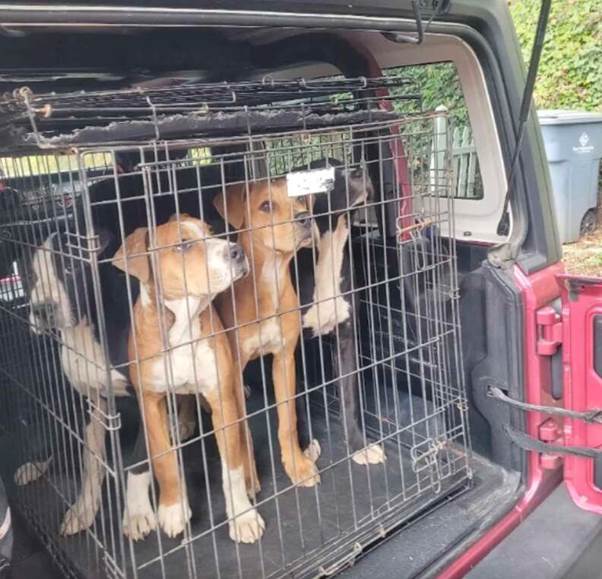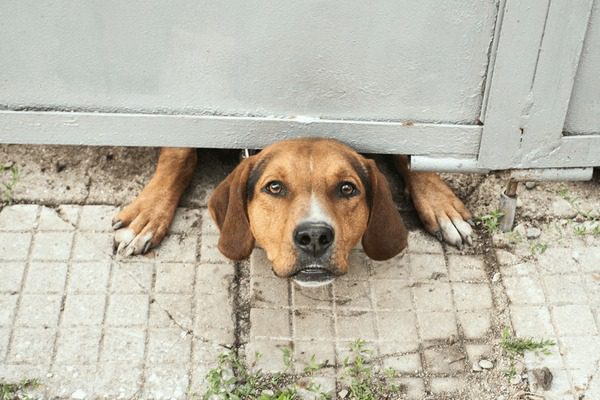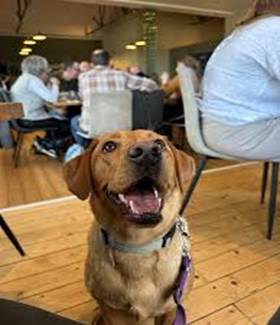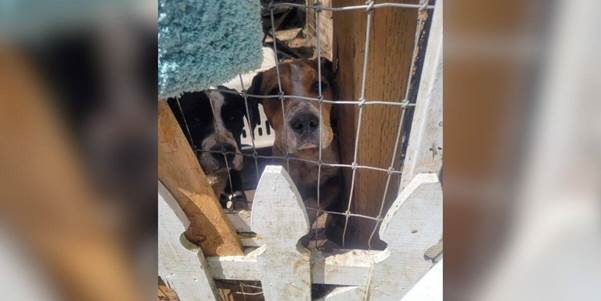For months, the house on Elm Street was just a blurred landmark on my route to work. The property was set back from the road, partially obscured by overgrown bushes, and always felt deeply quiet, almost abandoned. But one day, something was different. As I slowed at the stop sign, a flash of movement caught my eye.
It wasn’t an excited bark or a dog jumping high. It was a subtle, desperate glint of fur at the very bottom of a chain-link fence. There were two dogs: one a soft, dusty brown, the other a beautiful, grime-streaked Golden Retriever. They weren’t barking at me; they were peering through the fence, their noses pressed right against the rusty wire, their eyes fixed on the outside world as if waiting for a miracle.
I pulled over. The yard was an immediate red flag. The grass was long dead, replaced by a mixture of mud, weeds, and what looked like old, moldy trash. A broken plastic kennel offered the only apparent shelter, and the ground was dotted with large piles of feces—a grim indication of how long these dogs had been confined without proper cleanup or care.
The whole area screamed of neglect and abandonment, even though the main house was standing just yards away. The setting was squalid.I approached the fence slowly, speaking in a low, soothing tone. “Hey, guys. You’re alright. What are you doing back here?”
The dogs immediately retreated. They didn’t run in fear, but they backed away with slow, cautious steps—the kind of movement that signals deep-seated trauma rather than simple shyness. The Golden, whom I would later call Sunny, stopped about ten feet back. She was trembling slightly, her head lowered, avoiding direct eye contact. The brown dog, smaller and wirier, retreated even further, disappearing behind the broken plastic shelter, only his worried face visible.
It was heartbreaking. These dogs weren’t aggressive; they were broken. They wanted contact, evidenced by their initial presence at the fence, but every instinct told them that human interaction meant pain or disappointment. They were caught in a terrible limbo—trapped in a neglected space, yet too terrified to ask for help when it finally arrived.

I noticed their coats were dull and matted, and their ribs were visible beneath their fur. Most worryingly, their water bowl was tipped over and dry, and the food bowl contained only a few fly-covered crumbs. They weren’t just neglected; they were suffering.
I stayed there for twenty minutes, leaning against the fence, just talking softly about the weather and my day, trying to be a non-threatening presence. Gradually, Sunny became brave enough to move forward. She kept her body language deferential—a low crawl, a tail tucked tight—but she edged closer until her nose was just inches from the wire again. She didn’t sniff me, but just stared, her eyes pools of silent desperation.
It was the most powerful plea I had ever witnessed. It wasn’t a desperate bark for food or freedom; it was a quiet, almost resigned look that said, “Do you see us? Please, don’t leave us here.”
I took out my phone and documented everything: the filth, the lack of fresh water, the dogs’ physical condition, and their fearful demeanor. I got a clean shot of Sunny’s heartbreaking, pleading face, and the overall scene of the desolate yard. I knew this was more than a welfare check; it was a rescue mission.

That afternoon, I filed a detailed report with Animal Control, complete with the photographs that spoke a thousand words. The squalor and the visible distress of the dogs were enough to trigger an immediate investigation.
The next day, Animal Control officers, accompanied by a veterinarian, arrived at the property. The owners, it turned out, lived inside but rarely interacted with the dogs, leaving them permanently confined to the back yard with minimal resources. The timid, submissive way the dogs approached the rescuers confirmed the history of neglect.
The warrant was served, and the two dogs were officially seized.

The rescue process was slow and gentle. Sunny allowed the officers to leash her first, still trembling but seeming to understand that the touch was kind. The little brown dog, whom we named Ghost for his vanishing act, required more time and patience. He had to be carefully coaxed out from behind the broken shelter, clinging to the back corner of the yard until the gentle promise of freedom finally outweighed his fear.
Loaded safely into the Animal Control van, the two dogs, still timid, leaned against each other for comfort, just as they had done in their squalid prison.
At the shelter, their transformation began. They were given a warm bath—the first step in shedding the filth of their past—and a clean bill of health, though they were underweight and needed dental care. But most importantly, they were given kindness, quiet space, and the promise of safety.
It will take time for the fear to fade entirely. Sunny and Ghost are still cautious, still moving with that tentative, deferential crawl. But now, when they look at a human, they are starting to see an outstretched hand, not a threat. They are learning that the world outside the rusty chain-link fence is full of soft blankets, unlimited fresh water, and gentle voices.

The two friends remain together in a temporary, shared space at the shelter, gradually gaining the confidence they need to become individual, thriving dogs. They are no longer looking out through the fence for a hero; they are learning to trust the heroes who finally saw their silent plea and brought them home.


